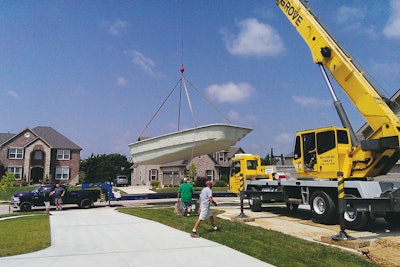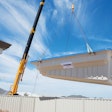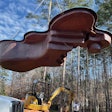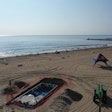
Fiberglass pools are obviously quite different from cast-in-place concrete, shotcrete, stainless steel, or vinyl-liner pools — not only in the materials of which the shells are made but in the way they are supported in the ground and the way the shell itself is handled. With the exception of stainless steel unitary pools, all the others utilize multiple steps to eventually arrive at a watertight structure. With fiberglass, the shell is in one piece and hoisted into place. It is immediately watertight once the plumbing has been connected and requires no further shell waterproofing, plaster, or tile (although tile can be installed on fiberglass pools).
This single-piece construction has a number of advantages but also brings with it some special construction techniques that must be observed.
MEASURING AND PLACING
The first thing an experienced pool contractor encounters in a fiberglass pool is that horizontal shell dimensions are not usually given on installation drawings to the waterline, but rather to the outer edge of the fiberglass lip or flange. This could cause problems with digging and locating the pool if the builder were caught unaware. Builders are cautioned with fiberglass (and with shotcrete and cast-in-place concrete pools as well) to pay attention to where dimensions are given.
Typically, fiberglass pool manufacturers will provide a layout and digging diagram or "yard Template" to enable the builder to precisely layout the pool on the ground before excavation. Be sure to check the diagonals shown in these plans to validate your right angles. Never attempt to "eyeball" a 90-degree angle.
 It may take several attempts of setting and re-lifting the shell to best fit the subgrade.
It may take several attempts of setting and re-lifting the shell to best fit the subgrade.
DIGGING THE POOL
Excavation of a swimming pool of any kind should be done with skilled operators with experience in pool digging. Regardless of the shell type, under-excavating or over-excavating is problematic. Every excess yard of pool excavation over and above the actual requirements is going to be replaced with something more expensive than dirt — flowable fill, concrete, or gravel. Every inch of under-excavation will require a laborer or two to hand-trim the pool edges, costing money on top of the machine excavator.
A fiberglass pool depends on the surrounding earth for much of its strength. It is not like a concrete shell or a stainless unitary pool which have structural rigidity. Natural soil, in situ, is most often the best supporting structure for a fiberglass pool, especially if it is consistent from top to bottom and on all sides of the pool. Changes in soil strata should be cause for concern. Clays operate differently than sands, and rock operates differently than loose soils. Consistency is the ideal material — uniform support under the pool. Unfortunately, that means we must frequently bring in materials to achieve that consistency.
Here are four things you should NEVER do when installing a fiberglass pool:
- Never attempt to use the excavated material for pool subgrade. It is difficult to get back the compaction of the original in situ soil and will result in settlement. Better to use the granular bedding material.
- Never attempt to place a fiberglass pool directly on bedrock. No matter how smooth it appears, the shell will not be uniformly supported.
- Never use pea gravel or field or blow sand. These materials are unstable, free flowing, and difficult to compact. One of the most frequent reasons for pool settling is the use of sand. Sand is too easily displaced to be stable and can settle under flooding conditions. Crushed stone is the best material to use for backfill.
- Never eyeball the floor excavation. Set screed rails in the bottom of the excavation using an engineer's level or laser to ensure the rails are at the proper elevation, 4 inches above subgrade, and parallel to one another on opposite side of the pool width. Always compact the granular fill with a plate compactor.
And finally, remember that the pool walls may not be vertical and, in fact, usually are not for structural reasons. It is not unusual for fiberglass pool walls to slope outward from the pool floor to the rim.
 The means of getting the shell to the excavated hole varies according to the architecture and landscape of the home. Here, a rented mobile crane is snugged up within a few feet of the garage door.
The means of getting the shell to the excavated hole varies according to the architecture and landscape of the home. Here, a rented mobile crane is snugged up within a few feet of the garage door.
SETTING THE POOL
When the shell arrives at the site, while still on the truck, would be a good time to thoroughly inspect the shell. Look for damage to the pool shell occurring in transit. Look for raw edges, cracks in the shell, penetrations that are not supposed to be there, delaminations, and discolorations.
Setting the pool may not be a one- time event. It may take several attempts of setting and re-lifting the shell to best fit the subgrade. Walk the perimeter of the set pool and look for how close the gravel base matches up to the pool shell. Now walk inside the set pool shell in your stocking feet, feeling with your feet how close the base is to the shell. Your feet may feel a little give, which is permissible, but the shell underfoot should rest on the gravel base uniformly. After assessing the setting, mark any locations where there is no apparent support, lift the pool, and regrade with the gravel material (not native excavated soil).
 Never attempt to use excavated material for the pool subgrade. A correct option is shown here.
Never attempt to use excavated material for the pool subgrade. A correct option is shown here.
WATER AND BACKFILL
For a shallow swimming pool less than or equal to 5 feet in depth, water can be added until it reaches the bottom of the lowest step without backfill behind the walls, but no deeper.
For deeper swimming pools, greater than 5 feet in depth, place backfill behind the deep walls in shallow lifts, proceeding carefully around the entire deep end. Do not fill one side full-depth and then the other; rather, proceed back and forth, keeping the backfill surface always within 9 to 12 inches of level. Slice and hand tamp but do not use mechanical packers or 'jumping jacks'. Fill to within 5 feet of the top of the pool. Add water until it reaches the bottom of the lowest step.
Continue backfilling the pool in shallow lifts, carefully slicing in the granular backfill material under haunches and cove radii. Never leave voids under a wall-to-floor or riser-to-tread radius! Add water such that the level of the backfill and the level of the water in the pool are within 6 inches of one another at all times.
Constantly check the level for the pool rim. Even if the pool was level when it was put into the hole, the process of backfilling and filling with water can cause walls to move and render the pool out of level. Frequent checks are necessary. Around tanning ledges and benches, sagging can occur and it may be necessary to use a wooden 2-by-4 to lever the upper wall back into position until backfill is completed. Some contractors have found it useful to use string lines to keep the pool walls aligned and level.
While fiberglass pool installation can provide its own unique challenges, having a greater understanding of the engineering, mechanics, and science behind fiberglass pool construction and installation can lead to years of happiness for your clients and years of success for your business.
This article first appeared in the February 2025 issue of AQUA Magazine — the top resource for retailers, builders and service pros in the pool and spa industry. Subscriptions to the print magazine are free to all industry professionals. Click here to subscribe.







































